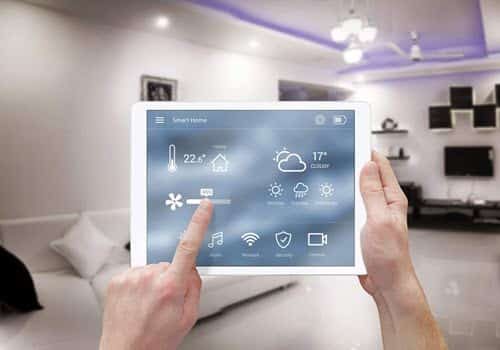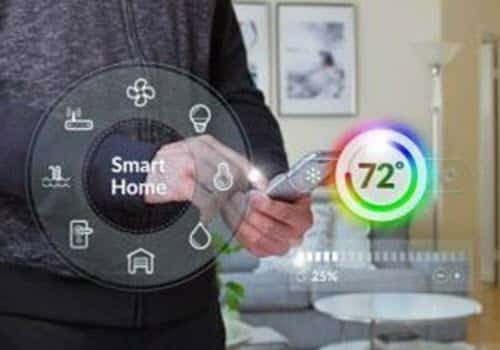Save Energy Using Programmable HVAC Thermostats
Every HVAC system includes a temperature-regulating device called a thermostat. The device is also used as a switch to turn the HVAC system off or on. Knowing what kind you have installed in your heating or cooling system helps in addressing possible issues you may encounter.
In most cases, if you call a technician over the phone with a thermostat problem, the technician is likely going to ask for the type of you have. The technician can quickly rule out possible issues by knowing the type of operation.
Types Of Air Conditioning Thermostats
There are several types used in home cooling and heating systems today. The most common kinds are:
• Manual
• Digital non-programmable
• Programmable
• Wireless
• Learning
• Communicating
Each type has distinct features that make them suitable for the varying needs of homeowners. Regardless if you favor a more conventional kind or you are more into the high-end and technologically advanced model, it remains a vital element in your HVAC system.
Manual Air Conditioning Thermostats
The most basic ones have technology that only works as a switch for the HVAC system. A manual HVAC thermostat works in such a way that when you turn it on and set it to a specific temperature, it will remain that way until you change the setting or turn it off. Also known as analog, manual ones are the earliest predecessors of thermostat technology.
Manual thermostats are easy to use. There is no need for you to learn complicated settings and program them. For people who prefer simplicity, manual ones remain a favorite. However, experts seem to agree that a manual one may not be the most efficient to use. Since there is no option to program the temperature according to the specific requirements of different areas in the home, you are likely using more energy than you actually need.
Digital Non-Programmable Thermostats
A step up to your analog manual HVAC thermostat, a digital non-programmable thermostat features a digital read-out. The display is easy to read while at the same time maintaining the functional simplicity of a manual thermostat. Digital thermostats are also taking over the market because old analog models used to contain harmful mercury.
Programmable Thermostats
A programmable thermostat takes away the hassle of manually adjusting the temperature. Once the setting is programmed on the thermostat, the device will regulate temperature on its own. Here are some examples of configurations you can put on a programmable HVAC thermostat:
- 7-day programming. People with hectic weekly schedules can benefit from using this type of programming. You can choose different settings for each day or the week with the additional option of adding different settings for different times of the day.
- 5-1-1 programming. Those who want a different setting for weekends can choose this option. You can set up one program for weekdays and another program for weekends. You also have the additional option of setting different programs for specific periods of the day.
- 5-2 programming. This is another programming option that allows you to set a separate program for weekdays and weekends.
- 1-week programming. This type of program is the simplest option, where you choose one setting for the entire week.
Programmable thermostats are becoming increasingly popular in households that want flexibility in setting temperature options without having to do it manually. With flexible programming, you can maximize the amount of energy used at different times of the day and days of the week according to when you have the least or the most requirements.
Wireless Thermostats
The term ‘wireless’ refers to how it communicates with your heating or cooling system. To facilitate the concept of wireless technology, there are HVAC thermostats that literally have no wires connected to your heating or cooling equipment and make use of remote sensors to communicate with the system.
Learning Thermostats
Sometimes referred to as a smart thermostat, learning thermostats are a relatively new innovation. It gives the illusion of being programmable without actually requiring you to program the device. It will program settings according to your preferences. You can manage and control smart thermostats via Wi-Fi or any wireless technology connected to your mobile device. However, a learning one suits households with consistent schedules; otherwise, if there is no consistency, it will not be able to program according to your preferences automatically.
Communicating Thermostats
Another advancement in HVAC thermostat technology is the inclusion of a communication system that allows the cooling or heating equipment to talk to the thermostat. A complete system may include additional features such as troubleshooting assistance and maintenance warnings.
Choosing The Right HVAC Thermostat For Your Home
Finding the right HVAC thermostat for your home heating and cooling system depends mainly on the type of heating or cooling system you have. This is crucial because every kind of heating or cooling system has varying requirements when it comes to wiring and voltage. You may also find that some models or types of thermostats may not be compatible with your heating or cooling system.
If you really want to know the kind of thermostat that will fit the existing HVAC system in your home, you should ask an expert technician.
The next step in choosing the right HVAC thermostat is to determine which features you desire. For example, you can select a programmable digital HVAC thermostat that gives you the flexibility to program temperature settings for different days of the week.
Once you have narrowed down the type of thermostat as well as the features you want, then you can start comparing models from different brands. You can also compare prices and read customers' reviews to help you choose the best one that suits your needs.
Why You Should Choose A Programmable Digital Thermostat
Digital and programmable HVAC thermostat units are slowly phasing out manual and analog thermostats. These days, most thermostats come with state-of-the-art touchscreen displays, wireless connectivity, smartphone compatibility, and so on. The prevalence of new HVAC thermostat technology happened for a good reason. The Department of Energy found that using a digital thermostat can save you as much as 10% each year on energy bills.
When you have the option to program your thermostat, it only operates at optimum capacity when needed. While anyone can argue that you just as quickly turn down or turn off a manual thermostat, there is always the factor of delay or the chance of forgetting to do it. If you live a busy life, a programmable digital thermostat can genuinely help increase your savings.
How To Maximize Energy Savings With A Programmable Digital Thermostat
It is true that you can save money by using a programmable one. However, it is still essential to know the proper use of such a device so that you can maximize the savings on your energy bills. Here are some tips for using a programmable HVAC thermostat.
- Take into account the outside temperature. When you program your thermostat, a significant disparity between the temperature you desire inside the home and the outside temperature will cause it to struggle. Instead of saving energy, you may end up using more if the system is working too hard to maintain the temperature inside. Without sacrificing comfort level, program your thermostat to a temperature setting close to the temperature outside the home to save on energy use.
- Be patient. This is difficult, especially when it is too hot or too cold outside. However, cranking up your thermostat to the highest or lowest setting, thinking it will cool or heat your home faster, will only extend the system’s capability. This means you will end up using more energy in the long run. Instead of setting the temperature too high or too low, choose the right degree and program it. Then, wait for the HVAC system to reach the desired temperature.
- Don’t forget about the programmable features of your thermostat. There is no use in buying a programmable one if you ignore the features and use it as a manual device. Learn how to navigate the settings and experiment with programming indoor temperature settings for different days of the week or for different times of the day. If you have a smart thermostat hooked up to an application on your smartphone, you can try using the features on your phone while you are away. The more you familiarize yourself with the settings, the more you will appreciate the benefits of having a programmable thermostat.
In addition to all of these tips, proper HVAC maintenance is also vital in saving energy. Regardless of how advanced your thermostat is, if you don’t regularly have your HVAC system cleaned and maintained, you won’t see much difference in your energy bills.
For all your HVAC repair, maintenance, and installation requirements, contact only the best and trusted heating companies in your area. Fischer Heating has years of experience in the industry, and they can help you with all your HVAC needs.
Contact Fischer Heating for any additional questions you may have, or give us a call today at 206-202-9499.
Discover More Ways To Stay Warm & Save
One of the ways is to stop fiddling with your thermostat because it can lead to wasted energy. Resetting your thermostat when you are away from home or when you are sleeping can save money on your cooling and heating bills. You can either do this manually or install a programmable thermostat or an automatic setback.
With that said, you might be wondering what temperature to set the thermostat in winter. Read More >
There are several types of thermostats you can consider installing. At the core, they all regulate temperature automatically and activate a device when a certain point in the temperature is reached. Simply put, it switches the heating system on and off automatically by sensing air temperature. But contrary to what many people believe, turning the thermostat in a room to a higher setting will not lead to the room heating up faster. The design of the heating system is what actually makes a room heat up quickly, not the thermostat. Read More >


